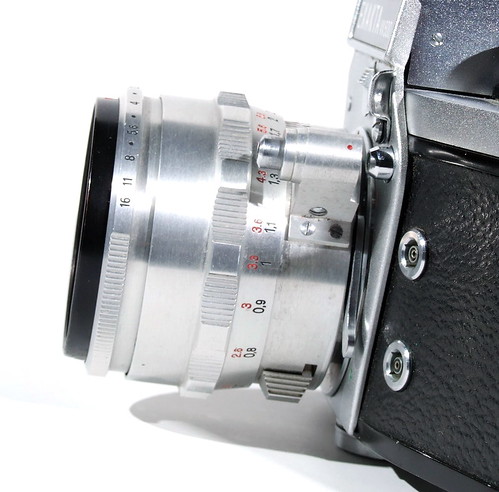Difference between revisions of "PAD"
(new glossary entry) |
m (wording tweak) |
||
| Line 9: | Line 9: | ||
}} | }} | ||
| − | In reference to lenses, '''PAD''' means "pressure activated diaphragm." It is also known | + | In reference to lenses, '''PAD''' means "pressure activated diaphragm." It is also known as '''APD''' for "automatic preset diaphragm." This was a mechanism seen in some 1950s lenses for [[Exakta]], [[Miranda]], and others, where a small arm protruding from the lens piggybacks overtop the shutter release on the front of a camera body. Finger pressure on its plunger closes down the lens [[diaphragm]] to the [[aperture]] selected on the f/stop ring, just before the shutter release is tripped. |
With the 1959 appearance of the [[Nikon F]] and other Japanese cameras offering internally-coupled, instant-reopen diaphragms, the popularity of the PAD approach soon waned. | With the 1959 appearance of the [[Nikon F]] and other Japanese cameras offering internally-coupled, instant-reopen diaphragms, the popularity of the PAD approach soon waned. | ||
Revision as of 03:12, 27 June 2011
Glossary Terms

|
| External diaphragm plunger (see another view) of 58mm f/2.0 Jena Biotar, aligned with shutter release of Exakta VX500 image by Süleyman Demir (Image rights) |
In reference to lenses, PAD means "pressure activated diaphragm." It is also known as APD for "automatic preset diaphragm." This was a mechanism seen in some 1950s lenses for Exakta, Miranda, and others, where a small arm protruding from the lens piggybacks overtop the shutter release on the front of a camera body. Finger pressure on its plunger closes down the lens diaphragm to the aperture selected on the f/stop ring, just before the shutter release is tripped.
With the 1959 appearance of the Nikon F and other Japanese cameras offering internally-coupled, instant-reopen diaphragms, the popularity of the PAD approach soon waned.